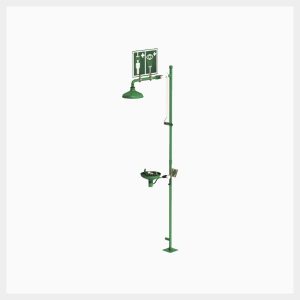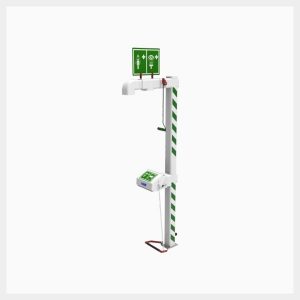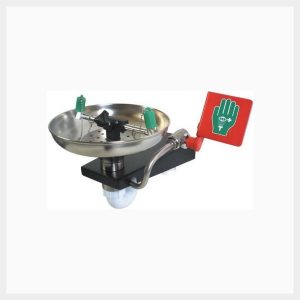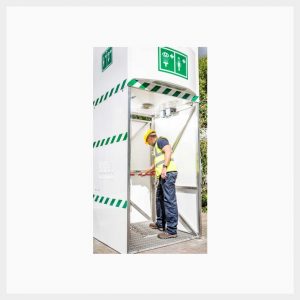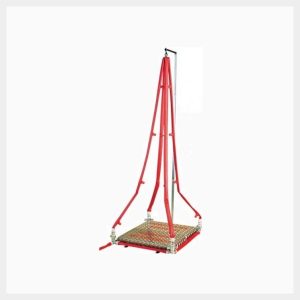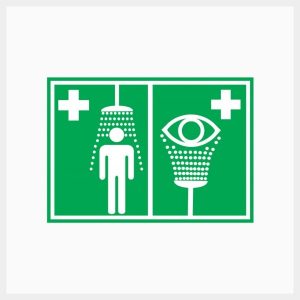Safety showers and eyewash stations: Protection in hazardous environments
At Spill Station, we’re all about quick action and cutting down the risk of injuries when accidents happen. That’s why we’ve put together a solid lineup of emergency safety showers and eyewash stations for immediate decontamination. Prevent minor incidents from turning into major accidents with our range of eyewashes and safety showers. Explore our range of emergency solutions today.
Safety showers for full-body decontamination
Safety showers provide an immediate decontamination solution for individuals exposed to hazardous substances. Designed for rapid deployment, these showers are essential in environments where spills, splashes or contact with dangerous chemicals can occur. Our safety showers for sale boast features that ensure a quick and effective washdown, helping to prevent serious injuries and skin contamination. They are ideal for industrial sites, chemical plants and anywhere comprehensive safety measures are required.
The main thing to know is we stand behind our product. All safety showers in the Hughes Safety Shower range have a 2-year warranty. That is double the warranty of any other shower supplier.
Eyewash stations for essential eye safety
In addition to a safety shower, an eyewash station is another essential safety measure for your workplace. Eyewash stations are a critical safety feature for any workplace dealing with chemicals and hazardous substances. Both units are crucial for comprehensive safety. While safety showers handle full-body decontamination, a specialised eyewash station is essential for safely flushing chemicals from the eyes, which are much smaller and highly sensitive, thus making it more challenging to cleanse effectively.
We’ve designed our units for instant access, allowing for immediate flushing of the eyes in the event of exposure to harmful materials. These units are a must-have in laboratories, manufacturing plants and any setting where there's a risk of chemical splashes. With features like hands-free operation and easily accessible controls, our eyewash stations minimise the damage by quickly diluting and washing away contaminants.
Durable construction for reliability
Constructed from high-quality materials resistant to chemicals and harsh conditions, our safety units are built to last. Whether you choose a standalone safety shower, a combination shower and eyewash unit or portable options for flexible placement, you can count on their reliability and durability in any situation. These units are designed to perform in the toughest environments, ensuring that they are ready when you need them most.
When combined, the main features of our safety showers and eyewash stations include:
- Valves:
- Virtually unbreakable.
- Purpose built patented design.
- Full bore ball valve.
- PTFE seals.
- Made from fully 316 stainless steel.
- 360 degree positively angled spindle.
- Fully enclosed valve stop assembly.
- Glass reinforced nylon lever.
- Spray Nozzle:
- Heavy-duty glass reinforced moulded nylon construction.
- Cyclonic delivery conical spray profile
- Complies with ANSI and Australian Standard spray profile requirements even at lower water pressures.
- Unlike common shower roses it will not become blocked by smaller particles.
- Piping:
- All pipes are made from semi-polished 304 stainless steel.
- All fittings are made from 316 stainless steel.
- Fully 316 stainless steel models are also available.
- Construction:
- The modular approach to construction provides maximum flexibility. All optional fittings including eyewash, eyewash operation pedal, signage and lighting can be easily retro-fitted to your safety shower if required.
Shop safety showers and eyewash stations fit for various industries
These emergency units are vital across a range of industries and settings, such as:
- Chemical manufacturing plants: Where the risk of chemical exposure is high, providing workers with immediate decontamination facilities is essential.
- Laboratories: Research and educational labs handling various substances can greatly reduce the risk of injury with easily accessible eyewash and safety shower stations.
- Industrial workplaces: In environments where machinery or processes use hazardous materials, having safety showers and eyewash stations nearby is a key safety measure.
- Construction sites: Portable units can significantly enhance safety in temporary work environments, where exposure to harmful substances can occur.
Choose safety showers and eyewash stations that comply with Australian safety standards
According to Australian Standard AS4775, these units must meet specific guidelines for design, installation and performance to ensure they provide immediate and effective decontamination during an emergency. Here's a summary of what you need to know about these safety standards:
- Safety showers must be located within 10 seconds of hazardous work areas.
- They must deliver a steady stream of water for at least 15 minutes.
At Spill Station, our range of high-quality safety showers and eyewash stations can help you meet and exceed these requirements, ensuring your workplace fully complies with regulations while providing top-tier protection for your team.
Enhance workplace safety with emergency showers and eyewash stations
Buy safety showers and eyewash stations at Spill Station and take a proactive step towards compliance with health and safety regulations. We designed our safety products with the end-user in mind. Our products combine functionality, durability and ease of use to provide effective emergency response solutions.
Enhance your facility’s safety measures today with Spill Station’s trusted range of safety showers and eyewash stations. For detailed information on our products, including specifications and installation guidelines, visit our catalogue page or contact our team for personalised advice. And to further equip your workplace to handle any emergency, consider our scheduled equipment maintenance service.
Secure your site with Spill Station’s comprehensive safety equipment
Trust Spill Station for your workplace's safety shower and eyewash stations. Our comprehensive safety equipment is built to last, delivering reliable performance when you need it most. From emergency decontamination to spill control and containment, Spill Station has got you covered. Visit Spill Station online today and discover our full range of products designed to meet your safety needs.
For detailed information on our products, including specifications and installation guidelines, visit our catalogue page or contact our team for personalised advice. And to further equip your workplace to handle any emergency, consider our scheduled equipment maintenance service.
Learn more about what we do and how we help you stay compliant.

